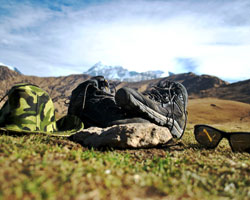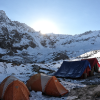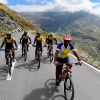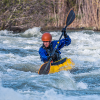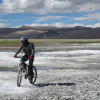During a full-fledged season of the Rupin Pass Trek some time ago, Pankaj (one of our founders) received a call about a bizarre situation that had developed on the slopes of the Rupin Pass. The call was from one of our guides who was assisting a batch of 8 trekkers there.
All participants had crossed the Pass successfully the previous day. But only six of the participants had made it to the next campsite, Ronti Gad. Two participants along with the Trek Leader, Pijush, were missing.
Simultaneously the previous day, right after crossing the Pass, Pijush had observed that a trekker, from another group, who was walking alongside them was in no condition to trek. The weather, to add to the spectacle, was briskly inching towards a white-out.
Pijush knew the rest of the team, were way ahead from where he was.
With the campsite almost half a day away and no access to camping equipment or food rations, it was now up to Pijush to decide the next course of action…
In precarious instances like these, the brunt of both, making the right decision in the face of uncertainty and being responsible for each participant’s safety, lands squarely on the Trek Leader.
One misstep or wrong judgement could compromise the safety of the entire team.
This begs the question:
How equipped/skilled are the trek leaders at Bikat Adventures to handle such scenarios?
Read on to find out.
Let’s begin at the very beginning.
Do you know how long it takes for Bikat Adventures to hire a trek leader?
It takes us six months to hire one trek leader! Yes, you read that right, 6 months.
So what do we do in these 6 months? Why do we have such a lengthy hiring process?
The hiring process starts with a basic interview round where we get to know the person.
This is followed by a technical round or what is commonly known as the Adventure Professional Workshop at Bikat Adventures.
This is a one day affair where we meet the applicants in person and pose situation-based questions to them. These questions are more often than not inspired from crisis management instances that have cropped up in the past on our treks and mountaineering expeditions.
Based on one’s performance in the Adventure Professional Workshop, an applicant is then sent on a test assignment with one of our senior trek leaders. This assignment is paid and is instrumental in helping us gain better insights into how one approaches on-field work.
This is followed by a couple of more field assignments (all paid) which are chosen based on the challenges they offer in terms of weather, terrain, group sizes and participants’ experience levels.
Feedback is then collected from our senior trek leaders, local staff members, and participants to assess the applicant’s performance on-field. If it is found to be satisfactory, the applicant is then hired as a Trek Leader.
“Such a lengthy hiring process is needed because of the capricious nature of the job. No institute or mountaineering course certification can prepare anyone for the real-time challenges encountered on-field. This means it isn’t prudent to arrive at a decision based on an applicant’s qualification on paper or efficient handling of one crisis.
To be able to think on the feet and make wise decisions on the go only come with extensive exposure, experience, and practice which is the major reason why the hiring process is designed the way it is. ”- Pankaj
Which brings us to the next question,
What are some qualities we look for in our trek leaders at the time of hiring?
To begin with the obvious, a certification in Basic Mountaineering Course from one of the recognised mountaineering institutes in India is mandatory.
“Other certifications, like AMC and Search and Rescue while preferred are not deal-breakers for someone just beginning their career in trek leading.
What is given greater precedence however, are the behavioural aspects.
How does s/he work under pressure?
Can s/he think on their feet?
Are they respectful towards the local staff?
How efficiently can they get work done?
How quickly do they learn new things?
In my opinion, these are the tougher qualities to imbibe, build upon, and master. A candidate who shows tenacity in these areas is usually more preferred than someone qualified in an advanced mountaineering course.”- Pankaj
How do we prepare our trek leaders to handle the challenges one encounters on-field?
This process is exceedingly methodical at Bikat Adventures. Bikat Adventures was clear about establishing a platform that enabled a systematic career growth for trek leaders.
But there were a couple of issues that needed addressing before we could do this. The first step was to build the required skillset necessary for the itineraries in our portfolio.
“As I mentioned earlier, to become a competent trek leader, one needs to consistently gain exposure on-field.
Speaking of challenges, I used to work in the medical device industry (manufacturing of surgical equipment) before Bikat Adventures. Over there, every new project/ideation began with a risk assessment. To put it very crudely, our job was to figure out how to build a tool that could be used on a patient without killing them.
We adopted the same approach when it came to building a comprehensive Annual Trek Leader Training Program. Back in 2016, our Operations Team at Bikat sat down and identified all the risks one can run into while trekking on any of the trails in our portfolio.
We then correlated these risks with what was taught in a mountaineering course (BMC, AMC and Search and Rescue Operations available in India). This helped us identify roughly 12-13 areas of knowledge-gap that needed filling in, in order to be able to handle the itineraries in our portfolio capably.
For example, no institute in India teaches Flash Flood Emergency Procedures or handling of Forest Fires.
Similarly, avalanche rescue and navigation is taught only in the Search and Rescue Operations Course which trek leaders generally opt to get certified in at a later stage.
Knowledge of Navigation (taught in Search and Rescue Operations), in particular, is crucial for trek leaders irrespective of what stage of the career they are in.
So, we approached NIM for help in building a specialised training program that would equip all our trek leaders in handling each of the risks we had identified. It took us 6 months to design the training modules and in 2017, we held our first Annual Training Program for our trek leaders in the NIM Campus.”- Pankaj

A snapshot of our annual training program at NIM.
This is one of the biggest perks of beginning a career in trek leading at Bikat Adventures. We invest enormously in the research and training process of our trek/expedition leaders.
“BMC, AMC and Search and Rescue Operations are excellent courses that pack a vast array of theoretical and on-field training in the short span of a month. But these aren’t comprehensive enough to handle the rigours of leading, say, a batch on a mountaineering expedition.
To give you an idea, the training and examination duration of well recognised Mountain Guide Programs of the world vary anywhere between 3-6 years. You can imagine the skillset and experience an Outdoor Leader building his/her career in the west would have then, especially given the access they have to an extensive array of trainings, many of which are not even available in India.” – Pankaj, Founder
At Bikat Adventures, we want our trek/expedition leaders to be on par. After all, our country is home to the most coveted range in mountaineering.
The only way to do this was by building customised training modules for ourselves. The customised Training Program (still a work in progress) that we now hold every year at NIM has been highly rewarding for our trek leaders (as you will later see in how niftily Piyush handled himself on the Rupin Pass).
Once the skillset was in place, Bikat Adventures began looking at how to hone these skills over time. We needed a clearly defined career path that challenged the trek leaders with tougher assignments. In short, we were looking to build a system that allowed the trek leaders to nurture and polish the skills they had been taught in order to be able to progress from trekking to mountaineering.
“Currently, there is no clarity on what to expect out of a career in Trek Leading in India. There are Junior Trek Leaders, Senior Trek Leaders, Training Head of Trek Leaders and finally Entrepreneurs (trek leaders who eventually start their own trekking firms in the industry).
We had a different vision. We wanted to build a fastidious system that allowed trek leaders to step into becoming full-fledged Expedition Leaders.
So we used a combination of factors to decide when a Trek leader was ready to handle the challenges in the next stage. To give you a rough idea, please refer to the table below.
Click here to view the table
According to this, it would take 5 years (along with a proven track record of performance) for a trek leader to build all the skills necessary to independently lead mountaineering expeditions at Bikat Adventures.”- Pankaj
What is the life of a trek leader like at Bikat Adventures?
The life of a trek leader at Bikat Adventures is extremely demanding but rewarding.
1.Bikat Adventures is one of the few organisations in the country where trek leaders undergo a systematic career growth all the way up to leading mountaineering expeditions.
The highest altitude we have conquered so far is Mt. Nun at 7,135 M. It is our first 7k+ peak.
“Our team to Mt Nun had three of Bikat’s Outdoor Leaders and just one participant.
I was leading the expedition. Rohit Mishra, who had led a couple of beginner mountaineering expeditions (Mt.Deo Tibba and M. Gangotri III) was the Assistant Expedition Leader. Lalit Yadav (Trek Leader at Bikat Adventures) was also placed on the team to get his first taste of mountaineering.
It didn’t matter that we did not have enough bookings in that batch.
Bikat Adventures is one of those rare organisations that pursues trekking and mountaineering for the sport and not just for the business of it, although the business is what allows us to finance such endeavours :)“ - Wakeel, Training and Expedition Head.

Our Expedition Team, Mt. Nun
To read more about our expedition to Mt. Nun, please read the article linked below.
2.In addition to providing a systematic career growth, the trek leaders are trained in emergency procedures for flash floods, forest fires and many more.
These trainings are not available anywhere in India.
3.Apart from the natural progression to leading mountaineering expeditions, trek leaders also get the excellent opportunity to diversify their outdoor skills.
Bikat Adventures is primarily an adventure learning organisation. Apart from treks, we also hold skiing courses, cycling expeditions (Manali-Khardungla and Tawang Bumla), and wild-life spotting activities.
These are remarkable avenues for trek leaders to hone and build upon their skills in the outdoors.
“As a trek leader, Bikat is one of the best places to begin building your career. It offers excellent avenues for learning and growth, be it progressing to leading mountaineering expeditions or diversifying your skills in equally demanding and challenging outdoor activities.
After slogging for many years in the corporate sector, I wanted to change my field. I wanted an offline life where my buddy (Bullet bike) and I could explore freely. I researched several options like food blogging, wine tasting, etc. But, everything required me to be hinged to a computer. Finally, after a long search, I landed upon the mountains!
After finishing all the necessary courses in mountaineering I started working as a Trek Leader. I have led multiple treks for several operators but there was something missing. I was looking for a more organized firm where I could make my mark and earn some experience. Thankfully, I found Bikat.
Bikat Adventures identified the potential I had and helped me branch out into a Managerial Position with time. And my most favourite part about working here is the encouragement that is given to pursue activities outside of the job. When I expressed my interest to master Scuba Diving, Bikat Adventures was not only encouraging but also supported me in my endeavour to make my dream come true.” – Sandeep Kumar (aka captain), Operations Manager, Bikat Adventures
Lastly, one of the biggest quirks of joining a relatively small but rapidly growing organisation is that you have the freedom to don on multiple hats.
“After working as an instructor with a couple of firms, I was looking for a versatile platform where I could employ many of my skills and learn newer ones as well. That is when I joined Bikat. I was the second employee here.
I gradually began learning everything I could on the field. So, to fit my style of working, Bikat Adventures gave me the freedom to ideate and take risks. They encouraged me to experiment with new things.
To give you an idea, I was a trek leader first, then became an Operations Manager, and eventually even handled Corporate Sales. Now, I handle Corporate Adventure Programs, lead expeditions and dabble with customer care sometimes.
And this has been rewarding for both of us. Together, we have done close to a 100 treks, implemented a plethora of programs like rock & wall climbing, safety workshops, mountaineering workshops, etc across industries (from corporates to Schools).”- Gulam Jeelani – Head of Adventure programs & B2B
These are some aspects that make working at Bikat Adventures a highly demanding but exciting experience. We encourage our team members to experiment, experience, learn and grow from all that we have to offer.
“I am thinking of taking a break from my corporate job for a year”. Can I work as a trek leader at Bikat Adventures during this time?
This is a question we have often received in our inboxes from enthusiastic trekkers over the years. And it is a request we have had to turn down, regrettably, every single time.
On the face of it, the job of a trek leader in the Himalayas has a glamorous appeal to it. Taking a break from corporate life to gain some outdoor leadership experience is a tempting offer, no doubt.
But, as attractive as the above propositions sound, we urge you to reconsider the hefty liability that goes hand in hand with the job.
Right from the moment you embark on a trek, you become responsible for the safety of every single participant in your group.
Surprises can pop up even on the most familiar of treks, the treks you think you know well and have led multiple batches multiple times like what happened with Piyush on the Rupin Pass.
“We have led countless batches to the Rupin Pass over the last ten years. Yet this was the first time, we had received a call about a trek leader who has gone missing along with the participants.
We arranged for a local rescue team to scour the camping area in and around Ronti Gad by foot immediately. It went futile.
The trek leader and participants were nowhere to be found.
At 3PM that day, much to the relief of everyone, Piyush with the remaining participants was located making his way to the campsite looking exhausted but unharmed.
Later in the day, I got on call with Pijush to find out what had happened. He told me that an independent trekker from another group was in no condition to walk after they had crossed the Pass. To make things worse, the weather was turning bad, edging closer to a white out by the minute.
It was going to be impossible for that trekker to make it to Ronti Gad that day. That much was clear. Between the participants and himself, there was enough food (aka snacks) to last them for the night.
So, after losing some altitude, Pijush quickly dug out an igloo (an emergency procedure taught in mountaineering courses and practised annually in our training programs), in the snow for the trekkers and himself to stay in for the night.
And that is how the missing members of the team had managed to survive the frigid night despite the bad weather and no access to sleeping bags or tents”- Pankaj, Founder
We will leave the longer version of this story replete with the finer details for some other time.
That said, this is the reason why we don’t encourage applications for short term roles in trek leading. It is a field that revolves around risks and uncertainties, most times known and sometimes unknown. Growth in Trek Leading demands an ungodly amount of time, patience, energy and hard work.
Only people who are truly passionate about the mountains and determined on building a career in it find the will power to stay.



